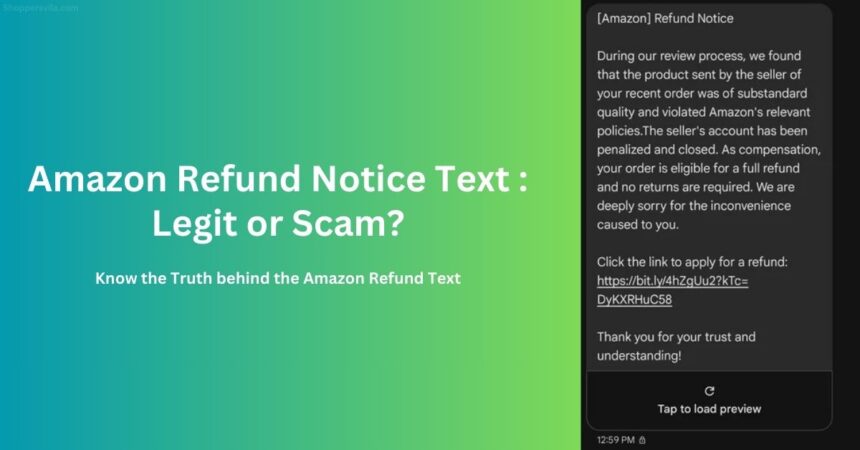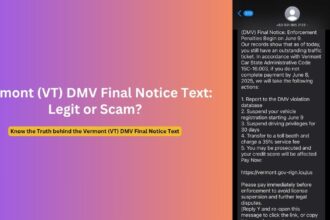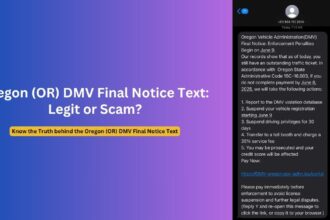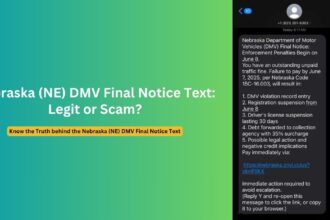A sophisticated new phishing campaign targeting Amazon customers has emerged in early 2025, with thousands of shoppers receiving deceptive text messages claiming to offer refunds for supposedly defective or policy-violating products. This widespread scam, which began circulating in January and continues to spread through March 2025, has already claimed numerous victims who unwittingly provided their login credentials or payment information to criminals.
How the Amazon Refund Text Scam Works
The scam operates through a simple yet effective method: victims receive a text message notice appearing to be from Amazon, informing them they’re eligible for a refund due to a merchant violating company policies or selling defective products. The message typically includes a shortened URL link that victims are instructed to click to “confirm” or “process” their refund.
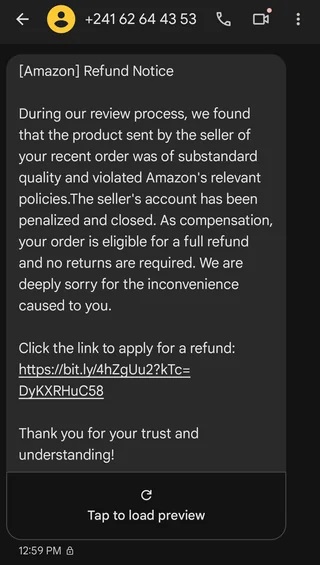
“I buy a lot from Amazon, and it has happened to me before where I was told by Amazon that something I bought was determined to violate their standards and they issued a refund way later,” shared one Reddit user who nearly fell victim to the scam. “I also first noticed this alert on my watch, so I didn’t really get a full view of it. Just saw ‘Amazon’ and ‘Refund,’ really.”
What makes this scam particularly effective is its timing. Many recipients report receiving these messages shortly after making legitimate Amazon purchases, suggesting scammers may be strategically timing their campaigns to coincide with peak shopping periods or may potentially have access to information about recent orders.
When victims click the link, they’re directed to a convincing but fraudulent Amazon login page. The page typically mimics Amazon’s design but contains subtle differences such as outdated copyright information or non-functional buttons. Those who enter their credentials unwittingly provide scammers with access to their Amazon accounts, potentially exposing saved payment methods, addresses, and personal information.
Some victims report that after entering their login information, they’re asked to provide full credit card details for “verification purposes”—a clear attempt to harvest financial data.
Red Flags to Watch For
Security experts have identified several consistent warning signs that can help consumers identify these fraudulent messages:
- Communication Channel: Amazon primarily uses email for refund notifications, not text messages. “I’ve been using Amazon since their book selling days and I’ve never got a text from them,” noted a longtime Amazon customer on Reddit.
- Suspicious Links: Legitimate Amazon communications use their own link shortener (a.co), whereas scam messages typically employ other shorteners like t.co, bit.ly, or long strings of random characters.
- Lack of Order Specificity: The scam messages rarely specify which exact item or order is affected, instead making vague references to “your recent orders” or “your purchase.”
- Urgency Tactics: Many messages include artificial time pressure, stating that action must be taken within 24 hours to receive the refund.
- Sender Information: Legitimate Amazon texts typically come from short codes (5-6 digit numbers), not regular phone numbers with area codes.
- Non-standard Web Addresses: If you examine the URL closely before clicking (which experts recommend), you’ll notice it doesn’t contain amazon.com in the main domain.
One victim who nearly completed the scam process reported, “It seemed odd, but could have gone either way. If it’s a fake site it takes you to, it sure looks real. I signed in and entered a code and everything, but then it asks you to enter your full card number for ‘verification’. That’s when I noped out.”
What To Do If You Receive a Suspicious Text
If you receive a text message claiming to be from Amazon about a refund, cybersecurity experts recommend the following steps:
- Don’t Click Any Links: Instead, open your Amazon app or go directly to Amazon.com by typing the address in your browser.
- Check Your Orders and Messages: Log into your legitimate Amazon account and check your order history and message center. Any legitimate refund or policy issue would be documented there.
- Report the Message: Forward suspicious texts to Amazon’s official fraud reporting channels and to your mobile carrier as spam.
- Block the Number: After reporting, block the sender to prevent further communication attempts.
- Delete the Message: Remove the message from your device to prevent accidentally clicking it later.
“I like to check my Amazon app for any messages there. Takes a second and makes it super easy to see if a message is legit or not,” advised one Reddit user who successfully identified the scam.
How to Stay Safe from Amazon-Related Text/e-mail Scams
To protect yourself from this and similar e-commerce scams, security professionals recommend several proactive measures:
Use Multi-Factor Authentication
Enable two-factor authentication on your Amazon account and all other online shopping platforms. This additional security layer means that even if scammers obtain your password, they cannot access your account without the secondary verification method.
Verify Through Official Channels
“Every order, refund, or other account action has been emailed to me, I never bother with the legit and not legit texts from ‘Amazon’,” shared another Reddit user, highlighting a key security practice: always verify through official channels.
If you receive any communication claiming to be from Amazon about refunds, account issues, or orders, ignore the provided links and instead:
- Open the Amazon app
- Visit amazon.com directly in your browser
- Call Amazon customer service using the number from their official website
Be Skeptical of “Too Good To Be True” Offers
One of the most effective aspects of this scam is the promise of a “free” refund without needing to return the product. While Amazon occasionally does issue refunds without requiring returns for low-value items or in specific situations, be extremely cautious of unsolicited messages offering such deals.
Regularly Monitor Your Accounts
Set up notifications for all purchases and account activities on Amazon and regularly review your order history, payment methods, and account details for any unauthorized changes or transactions.
What To Do If You’ve Fallen Victim
If you’ve already clicked a suspicious link and provided information before realizing it was a scam, take immediate action:
- Change Your Password: Immediately change your Amazon password and any other accounts where you use the same or similar passwords.
- Enable Additional Security: Add or update two-factor authentication on your Amazon account.
- Contact Amazon: Report the incident to Amazon’s official customer service.
- Monitor Your Payment Methods: Check your credit card and bank statements for unauthorized charges and consider requesting new card numbers from your financial institutions.
- Check Connected Services: Review and revoke access to any third-party services connected to your Amazon account that you don’t recognize or use.
- File Reports: Consider filing reports with:
- The Federal Trade Commission (FTC)
- Your local police department
- The FBI’s Internet Crime Complaint Center (IC3)
One user who fell victim shared their experience: “They got me with this scam. I ordered parts for building a PC on Amazon. Got a great deal on a motherboard maybe a little too good. Got an email from Amazon that the store that had it listed is no longer active on Amazon a day after I ordered. A day later I get a text saying the store violated Amazon’s policies and to click link to get full refund so I thought it was legit. Well it was not but thank god I had a bad feeling and immediately went to Amazon and changed my password.”
The Bigger Picture
This Amazon refund scam is part of a larger trend of increasingly sophisticated phishing attacks targeting e-commerce customers. According to cybersecurity experts, these scams are becoming more convincing and harder to detect, often incorporating elements of social engineering and psychological manipulation.
What makes the current Amazon refund scam particularly effective is its ability to exploit legitimate customer experiences. Many Amazon users have genuinely experienced situations where products were refunded due to policy violations or quality issues, making the scenario presented in the scam messages plausible enough to lower consumers’ natural defenses.
As one near-victim noted, “The scams are getting really good. I am very much a snob about them and often wonder how people fall for some of these things, but I 100% guarantee my wife (who I have taught/annoyed a lot about scams) would get caught in this one, and I couldn’t really blame her.”
As e-commerce continues to grow and digital shopping becomes increasingly ubiquitous, consumers must remain vigilant and adopt a skeptical approach to all unsolicited communications, even those appearing to come from trusted brands like Amazon.
Remember: when in doubt, go directly to the source—Amazon’s official website or app—rather than clicking on links in texts or emails, no matter how legitimate they might appear.
